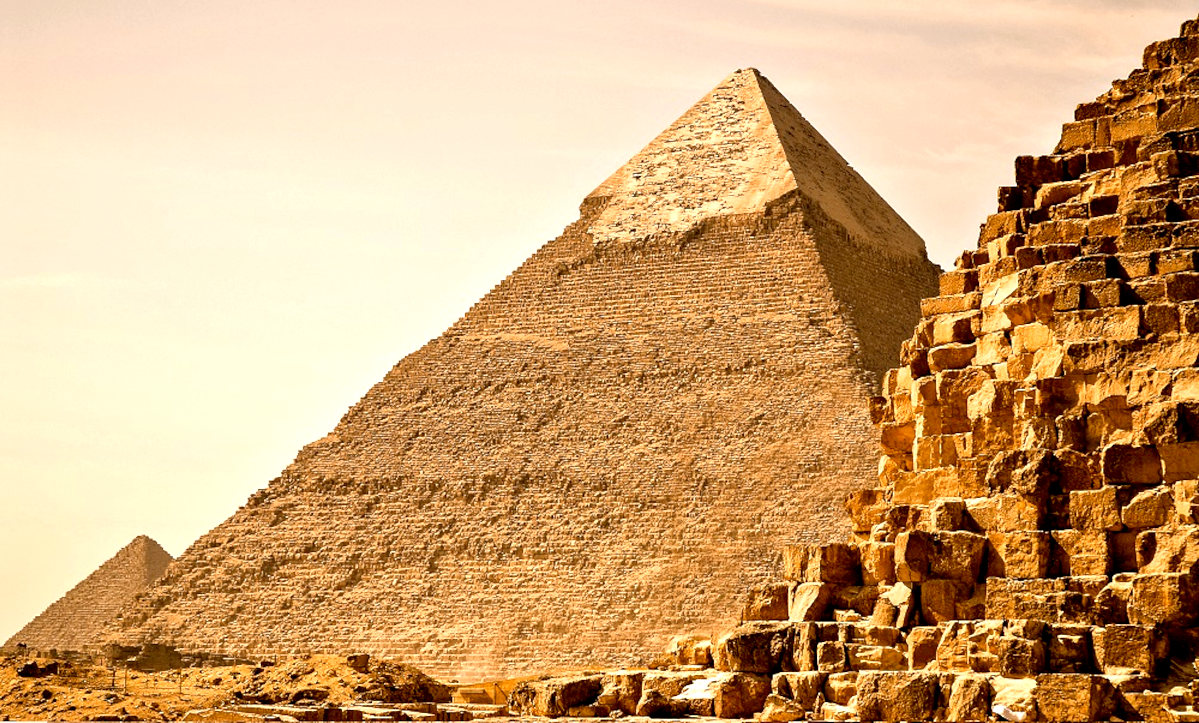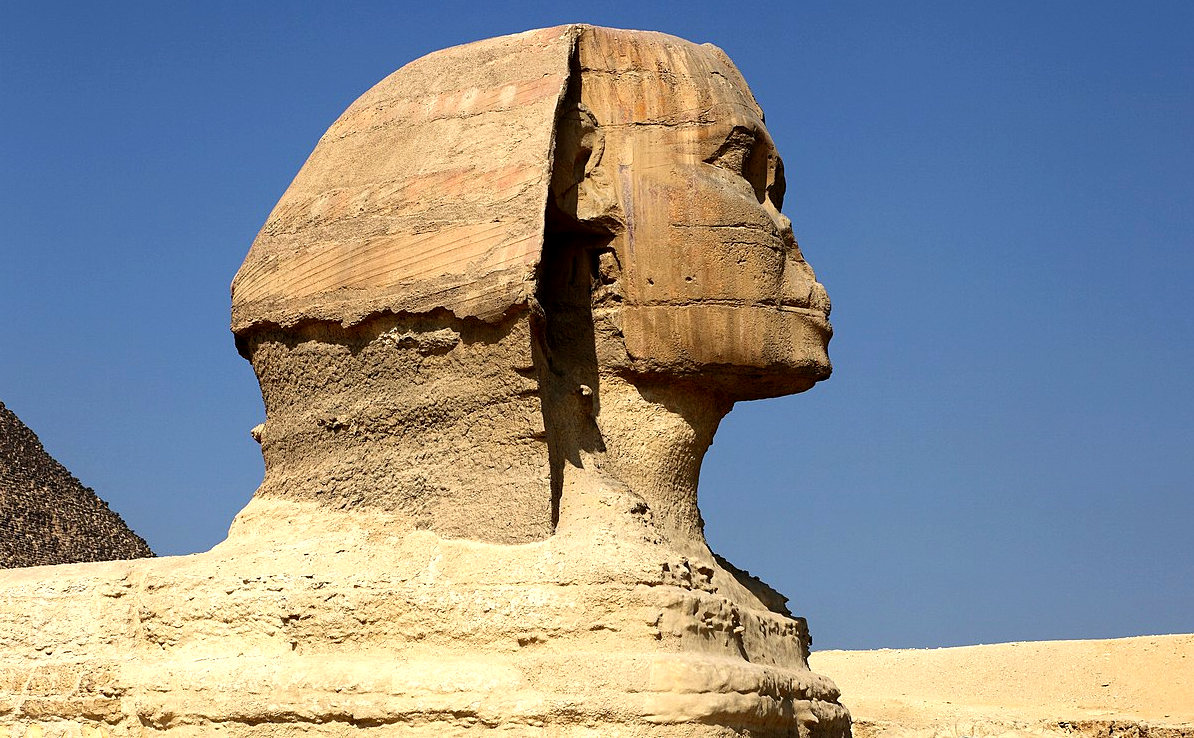
2015:
Sand is an abrasive medium to
Limestone, when it is driven by harsh winds. Considering the
heating an cooling in the desert environment, it is indeed a
wonder that the Sphinx and pyramids that this monumental
Sphinx is guarding.
Giza is the second-largest city in Egypt after Cairo.
It is located on the west bank of the
Nile,
and home to the Great Pyramid of Giza, and
the oldest monumental statue known to man: the Great Sphinx
of Giza.
The Great Sphinx
is a limestone statue of a reclining sphinx, a mythical creature with the head of a human, and the body of a lion. Facing directly from west to east, it stands on the Giza Plateau on the west bank of the Nile in Giza, Egypt. The face of the Sphinx appears to represent the pharaoh Khafre.
The original shape of the Sphinx was cut from the bedrock, and has since been restored with layers of limestone blocks. It measures 73 m (240 ft) long from paw to tail, 20 m (66 ft) high from the base to the top of the head and 19 m (62 ft) wide at its rear haunches. Its nose was broken off for unknown reasons between the 3rd and 10th centuries AD.
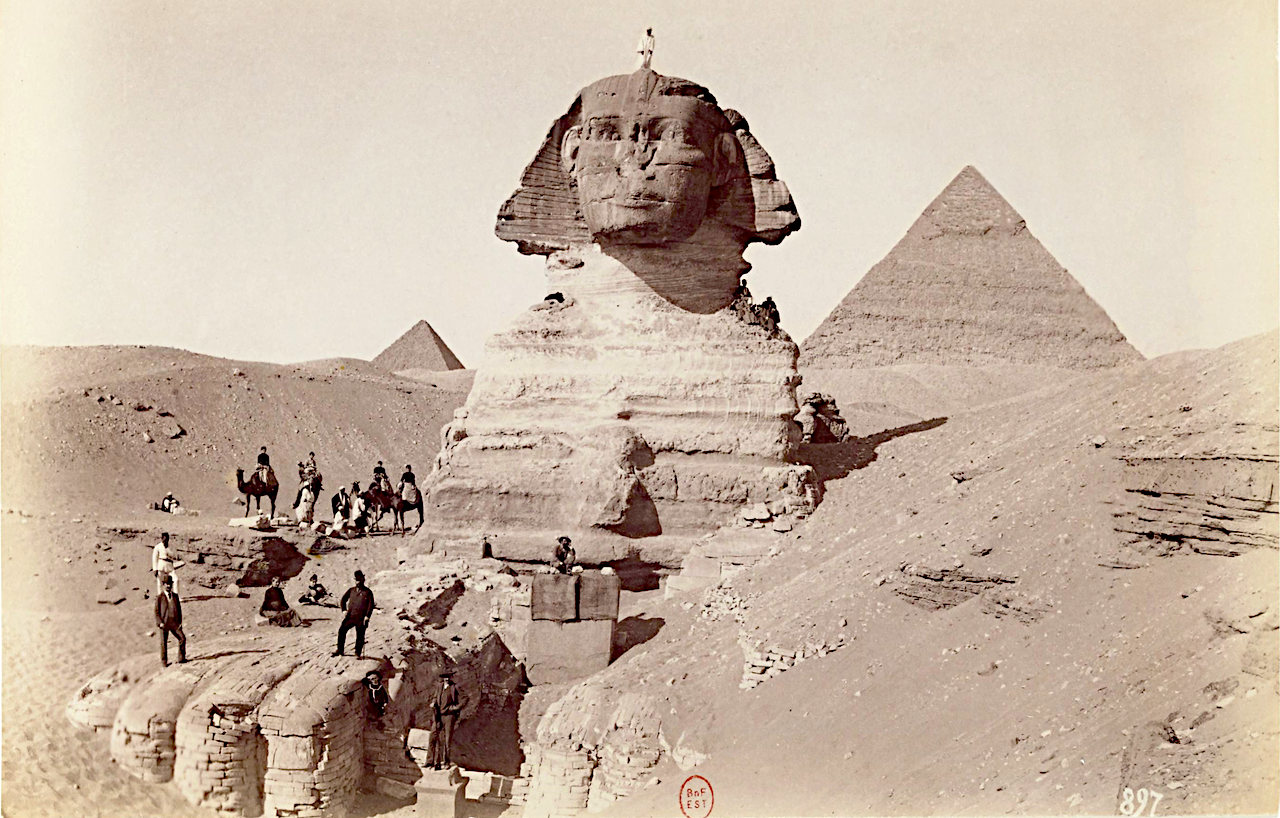
1880:
A photograph taken in 1880,
with the Sphinx covered in the shifting sands of time. The
visiting archaeologist, who came on camels are wearing suits
and hats, with local experts to explain important features.
The Sphinx is the oldest known monumental sculpture in Egypt and one of the most recognisable statues in the world. The archaeological evidence suggests that it was created by ancient Egyptians of the Old Kingdom during the reign of Khafre (c. 25582532 BC).
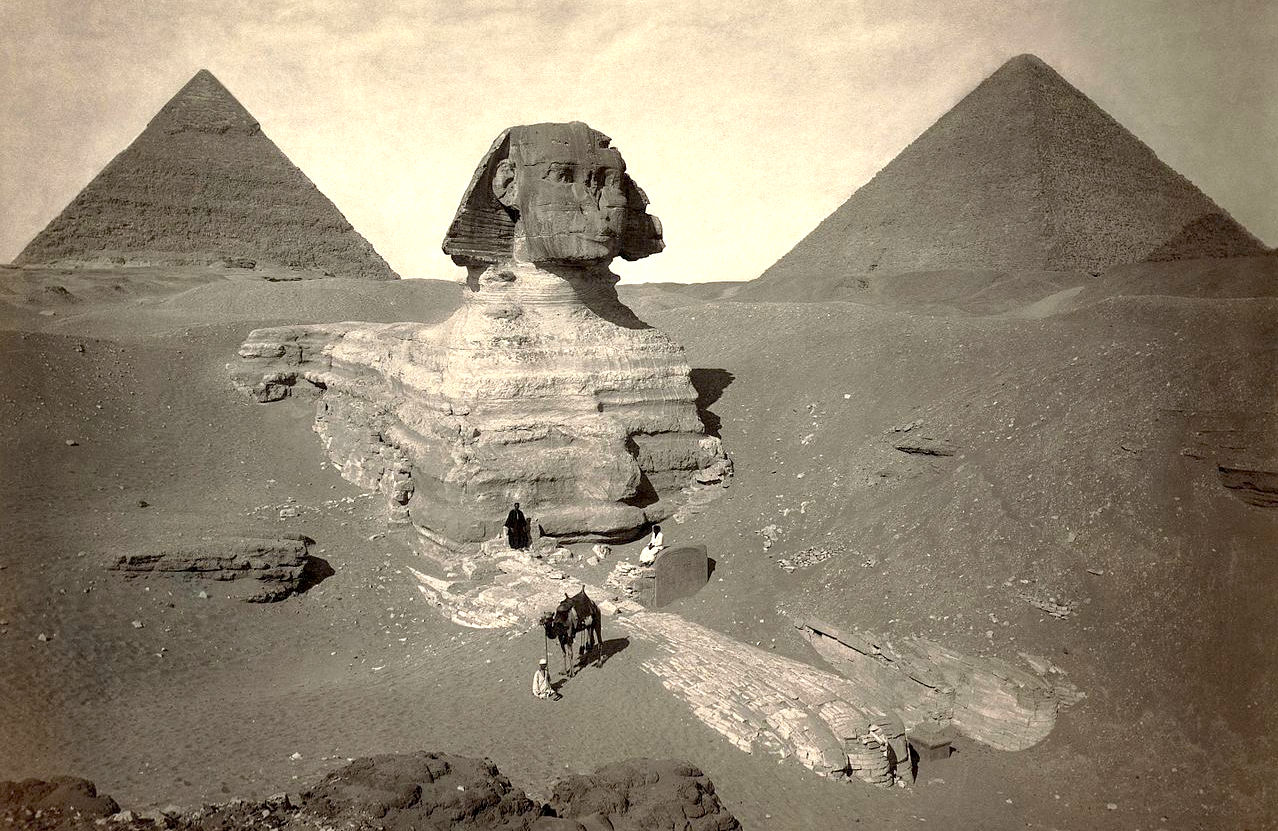
1878:
This stunning monument is
seen here swallowed by the desert sands. Who would not have wanted to lend a
hand, to allow an adoring public to see the Sphinx in all it's glory. The
Dream Stele (a granite slab between the front legs) is clearly visible.
Khafre's pyramid to the left, Khufu's (great) pyramid to the right.
OLD KINGDOM HISTORY
The Sphinx is a monolith carved from the bedrock of the plateau, which also served as the quarry for the pyramids and other monuments in the area. Egyptian geologist Farouk El-Baz has suggested that the head of the Sphinx may have been carved first, out of a natural yardang, i.e. a ridge of bedrock that had been sculpted by the wind. These can sometimes achieve shapes which resemble animals. El-Baz suggests that the "moat" or "ditch" around the Sphinx may have been quarried out later to allow for the creation of the full body of the sculpture.
The archaeological evidence suggests that the Great Sphinx was created around 2500 BC for the pharaoh Khafre, the builder of the Second
Pyramid at Giza. The stones cut from around the Sphinx' body were used to construct a temple in front of it, however neither the enclosure nor the temple were ever completed, and the relative scarcity of Old Kingdom cultural material suggests that a Sphinx cult was not established at the time.
Selim Hassan, writing in 1949 on recent excavations of the Sphinx enclosure, made note of this circumstance:
Taking all things into consideration, it seems that we must give the credit of erecting this, the world's most wonderful statue, to Khafre, but always with this reservation: that there is not one single contemporary inscription which connects the Sphinx with Khafre, so sound as it may appear, we must treat the evidence as circumstantial, until such time as a lucky turn of the spade of the excavator will reveal to the world a definite reference to the erection of the Sphinx.
In order to construct the temple, the northern perimeter-wall of the Khafre Valley Temple had to be deconstructed, hence it follows that the Khafre funerary complex preceded the creation of the Sphinx and its temple. Furthermore, the angle and location of the south wall of the enclosure suggests the causeway connecting Khafre's Pyramid and
Valley Temple already existed before the Sphinx was planned. The lower base level of the Sphinx temple also indicates that it doesn't pre-date the Valley Temple.
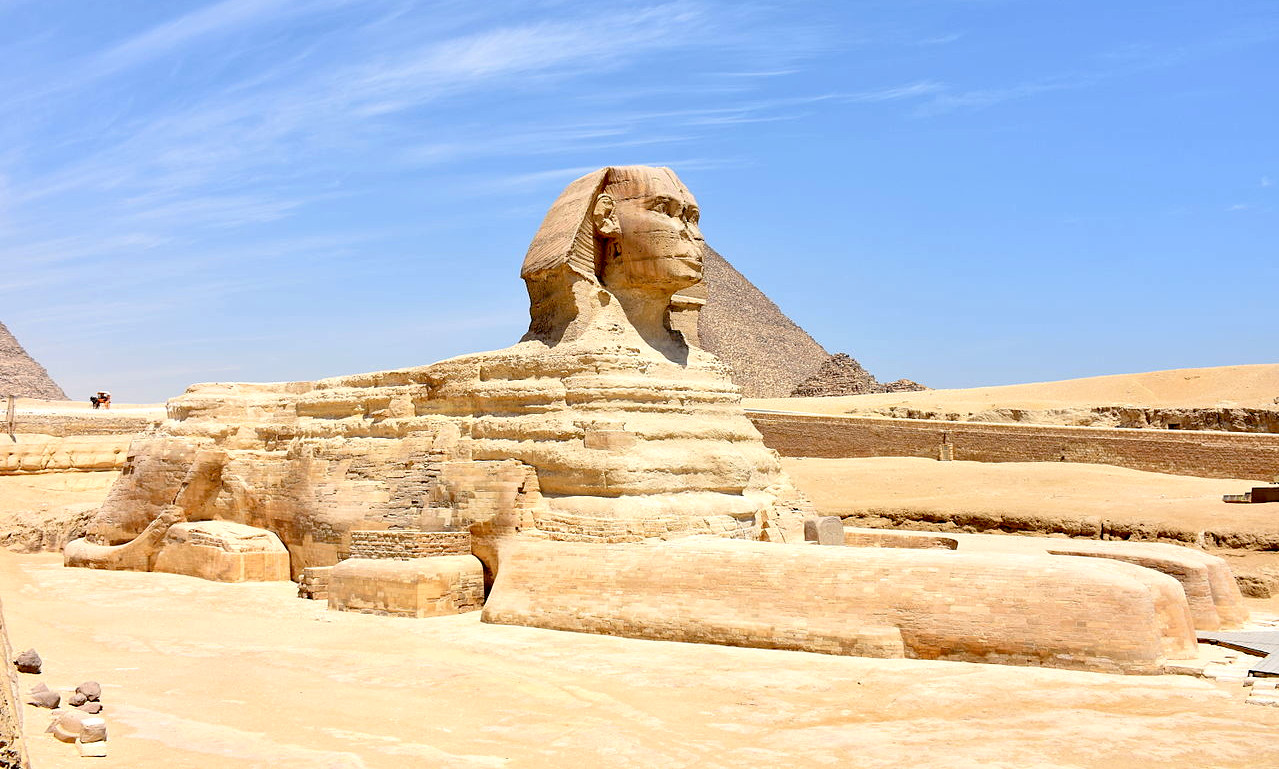
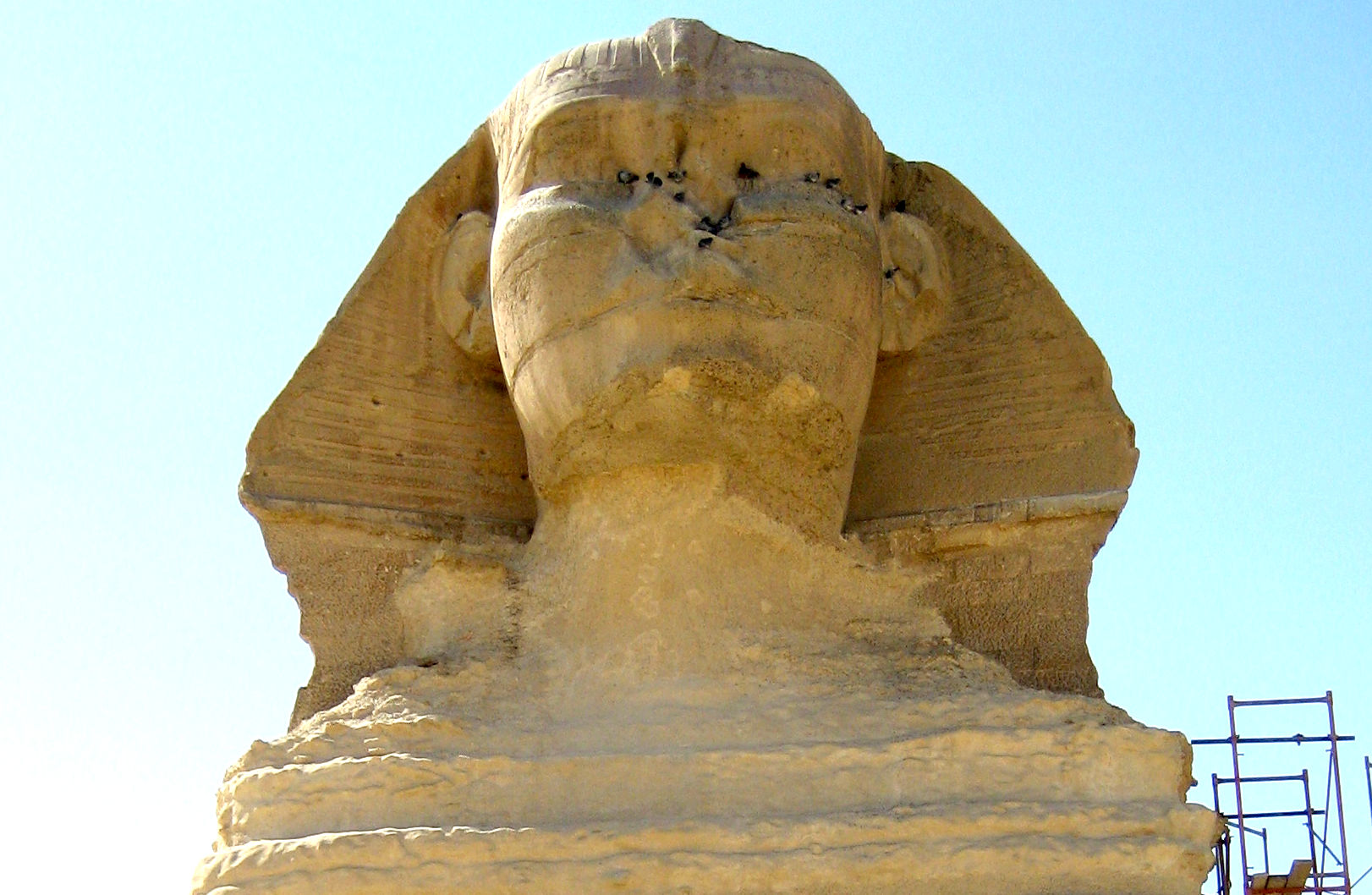
NEW KINGDOM
Some time around the First Intermediate Period, the Giza Necropolis was abandoned, and drifting sand eventually buried the Sphinx up to its shoulders. The first documented attempt at an excavation dates to c. 1400 BC, when the young Thutmose IV (14011391 or 13971388 BC) gathered a team and, after much effort, managed to dig out the front paws, between which he erected a shrine that housed the Dream Stele, an inscribed granite slab (possibly a repurposed door lintel from one of Khafre's temples). When the stele was discovered, its lines of text were already damaged and incomplete. An excerpt reads:
... the royal son, Thothmos, being arrived, while walking at midday and seating himself under the shadow of this mighty god, was overcome by slumber and slept at the very moment when Ra is at the summit [of heaven]. He found that the Majesty of this august god spoke to him with his own mouth, as a father speaks to his son, saying: Look upon me, contemplate me, O my son Thothmos; I am thy father, Harmakhis-Khopri-Ra-Tum; I bestow upon thee the sovereignty over my domain, the supremacy over the living ... Behold my actual condition that thou mayest protect all my perfect limbs. The sand of the desert whereon I am laid has covered me. Save me, causing all that is in my heart to be executed.
The Dream Stele associates the Sphinx with Khafre, however this part of the text is not entirely intact:
which we bring for him: oxen ... and all the young vegetables; and we shall give praise to Wenofer ... Khaf ... the statue made for Atum-Hor-em-Akhet.
Egyptologist Thomas Young, finding the Khaf hieroglyphs in a damaged cartouche used to surround a royal name, inserted the glyph ra to complete Khafre's name. When the Stele was re-excavated in 1925, the lines of text referring to Khaf flaked off and were destroyed.
Later, Ramesses II the Great (12791213 BC) may have undertaken a second excavation.
In the New Kingdom, the Sphinx became more specifically associated with the sun god Hor-em-akhet (Hellenized: Harmachis) or "Horus-at-the-Horizon". Pharaoh Amenhotep II (14271401 or 1397 BC) built a temple to the northeast of the Sphinx nearly 1000 years after its construction and dedicated it to the cult of Hor-em-akhet.
In Graeco-Roman times, Giza had become a tourist destination
- the monuments were regarded as
antiquities - and some Roman Emperors visited the Sphinx out of curiosity, and for political reasons.
The Sphinx was cleared of sand again in the first century AD in honor of Emperor Nero and the Governor of Egypt Tiberius Claudius Balbilus. A monumental
stairway - more than 12 metres (39 ft) wide - was erected, leading to a pavement in front of the paws of the Sphinx. At the top of the stairs, a podium was positioned that allowed view into the Sphinx sanctuary. Further back, another podium neighbored several more steps. The stairway was dismantled during the 193132 excavations by Ιmile Baraize.
Pliny the Elder describes the face of the Sphinx being colored red and gives measurements for the statue.
